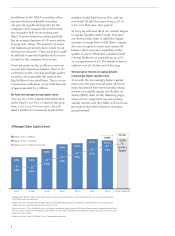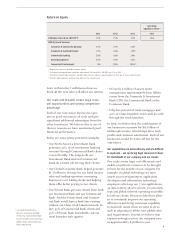JP Morgan Chase 2013 Annual Report Download - page 11
Download and view the complete annual report
Please find page 11 of the 2013 JP Morgan Chase annual report below. You can navigate through the pages in the report by either clicking on the pages listed below, or by using the keyword search tool below to find specific information within the annual report.-
 1
1 -
 2
2 -
 3
3 -
 4
4 -
 5
5 -
 6
6 -
 7
7 -
 8
8 -
 9
9 -
 10
10 -
 11
11 -
 12
12 -
 13
13 -
 14
14 -
 15
15 -
 16
16 -
 17
17 -
 18
18 -
 19
19 -
 20
20 -
 21
21 -
 22
22 -
 23
23 -
 24
24 -
 25
25 -
 26
26 -
 27
27 -
 28
28 -
 29
29 -
 30
30 -
 31
31 -
 32
32 -
 33
33 -
 34
34 -
 35
35 -
 36
36 -
 37
37 -
 38
38 -
 39
39 -
 40
40 -
 41
41 -
 42
42 -
 43
43 -
 44
44 -
 45
45 -
 46
46 -
 47
47 -
 48
48 -
 49
49 -
 50
50 -
 51
51 -
 52
52 -
 53
53 -
 54
54 -
 55
55 -
 56
56 -
 57
57 -
 58
58 -
 59
59 -
 60
60 -
 61
61 -
 62
62 -
 63
63 -
 64
64 -
 65
65 -
 66
66 -
 67
67 -
 68
68 -
 69
69 -
 70
70 -
 71
71 -
 72
72 -
 73
73 -
 74
74 -
 75
75 -
 76
76 -
 77
77 -
 78
78 -
 79
79 -
 80
80 -
 81
81 -
 82
82 -
 83
83 -
 84
84 -
 85
85 -
 86
86 -
 87
87 -
 88
88 -
 89
89 -
 90
90 -
 91
91 -
 92
92 -
 93
93 -
 94
94 -
 95
95 -
 96
96 -
 97
97 -
 98
98 -
 99
99 -
 100
100 -
 101
101 -
 102
102 -
 103
103 -
 104
104 -
 105
105 -
 106
106 -
 107
107 -
 108
108 -
 109
109 -
 110
110 -
 111
111 -
 112
112 -
 113
113 -
 114
114 -
 115
115 -
 116
116 -
 117
117 -
 118
118 -
 119
119 -
 120
120 -
 121
121 -
 122
122 -
 123
123 -
 124
124 -
 125
125 -
 126
126 -
 127
127 -
 128
128 -
 129
129 -
 130
130 -
 131
131 -
 132
132 -
 133
133 -
 134
134 -
 135
135 -
 136
136 -
 137
137 -
 138
138 -
 139
139 -
 140
140 -
 141
141 -
 142
142 -
 143
143 -
 144
144 -
 145
145 -
 146
146 -
 147
147 -
 148
148 -
 149
149 -
 150
150 -
 151
151 -
 152
152 -
 153
153 -
 154
154 -
 155
155 -
 156
156 -
 157
157 -
 158
158 -
 159
159 -
 160
160 -
 161
161 -
 162
162 -
 163
163 -
 164
164 -
 165
165 -
 166
166 -
 167
167 -
 168
168 -
 169
169 -
 170
170 -
 171
171 -
 172
172 -
 173
173 -
 174
174 -
 175
175 -
 176
176 -
 177
177 -
 178
178 -
 179
179 -
 180
180 -
 181
181 -
 182
182 -
 183
183 -
 184
184 -
 185
185 -
 186
186 -
 187
187 -
 188
188 -
 189
189 -
 190
190 -
 191
191 -
 192
192 -
 193
193 -
 194
194 -
 195
195 -
 196
196 -
 197
197 -
 198
198 -
 199
199 -
 200
200 -
 201
201 -
 202
202 -
 203
203 -
 204
204 -
 205
205 -
 206
206 -
 207
207 -
 208
208 -
 209
209 -
 210
210 -
 211
211 -
 212
212 -
 213
213 -
 214
214 -
 215
215 -
 216
216 -
 217
217 -
 218
218 -
 219
219 -
 220
220 -
 221
221 -
 222
222 -
 223
223 -
 224
224 -
 225
225 -
 226
226 -
 227
227 -
 228
228 -
 229
229 -
 230
230 -
 231
231 -
 232
232 -
 233
233 -
 234
234 -
 235
235 -
 236
236 -
 237
237 -
 238
238 -
 239
239 -
 240
240 -
 241
241 -
 242
242 -
 243
243 -
 244
244 -
 245
245 -
 246
246 -
 247
247 -
 248
248 -
 249
249 -
 250
250 -
 251
251 -
 252
252 -
 253
253 -
 254
254 -
 255
255 -
 256
256 -
 257
257 -
 258
258 -
 259
259 -
 260
260 -
 261
261 -
 262
262 -
 263
263 -
 264
264 -
 265
265 -
 266
266 -
 267
267 -
 268
268 -
 269
269 -
 270
270 -
 271
271 -
 272
272 -
 273
273 -
 274
274 -
 275
275 -
 276
276 -
 277
277 -
 278
278 -
 279
279 -
 280
280 -
 281
281 -
 282
282 -
 283
283 -
 284
284 -
 285
285 -
 286
286 -
 287
287 -
 288
288 -
 289
289 -
 290
290 -
 291
291 -
 292
292 -
 293
293 -
 294
294 -
 295
295 -
 296
296 -
 297
297 -
 298
298 -
 299
299 -
 300
300 -
 301
301 -
 302
302 -
 303
303 -
 304
304 -
 305
305 -
 306
306 -
 307
307 -
 308
308 -
 309
309 -
 310
310 -
 311
311 -
 312
312 -
 313
313 -
 314
314 -
 315
315 -
 316
316 -
 317
317 -
 318
318 -
 319
319 -
 320
320 -
 321
321 -
 322
322 -
 323
323 -
 324
324 -
 325
325 -
 326
326 -
 327
327 -
 328
328 -
 329
329 -
 330
330 -
 331
331 -
 332
332 -
 333
333 -
 334
334 -
 335
335 -
 336
336 -
 337
337 -
 338
338 -
 339
339 -
 340
340 -
 341
341 -
 342
342 -
 343
343 -
 344
344
 |
 |

99
1 Calculated based on gross
domestic investment banking
revenue for syndicated leverage
finance, mergers and acquisitions
(M&A), equity underwriting and
bond underwriting
Later in this letter, I will discuss how we
think all the new rules will aect our returns.
Our scale and breadth create large cross-
sell opportunities and strong competitive
advantage
Each of our four major businesses oper-
ates at good economies of scale and gets
significant additional advantages from the
other businesses. We believe this is one of
the key reasons we have maintained good
financial performance.
Below are some pretty powerful examples:
• Our North America Investment Bank
generates 29% of its investment banking
revenue1 through Commercial Bank clients
covered locally. This helps both our
Investment Bank and our Commercial
Bank do a better job serving their clients.
• Our Global Corporate Bank helped generate
$1.3 billion in revenue for our fixed income
sales and trading operation, increasing
business to our trading desks and helping
them oer better pricing to our clients.
• Our Private Bank gets new clients from both
our Investment Bank and our Commercial
Bank. And the Private Bank and Commer-
cial Bank would have a hard time existing
without our Chase retail branch network. In
fact, 55% of Commercial Bank clients and
35% of Private Bank households visit our
retail branches each quarter.
• Of our $1.6 trillion of assets under
management, approximately $300 billion
comes from the Corporate & Investment
Bank (CIB), the Commercial Bank or the
Consumer Bank.
• Fifty-ve percent of retail mortgages and
40% of Chase-branded credit cards are sold
through the retail branches.
In total, we believe that the combination of
our businesses accounts for $15 billion of
additional revenue, which helps drive both
profits and customer satisfaction. Each of our
businesses would be worse o but for the
other three.
Our capabilities are extraordinary and are dicult
to replicate — we can bring huge resources to bear
for the benefit of our company and our clients
Our scale creates huge cost eciencies and
enables significant resources to be brought
to bear for the benefit of our company. For
example, in global technology, we have
nearly 30,000 programmers, application
developers and information technology
employees who keep our 7,200 applications,
32 data centers, 58,000 servers, 300,000 desk-
tops and global network operating smoothly
for all our clients. Resources like these allow
us to constantly improve our operating
eciencies and bring enormous capability
to deal with issues when we need to do so
such as adjusting to all the new global rules
and requirements. In total, we believe that
expense synergies across the company save
us approximately $3 billion a year.
Return on Equity
Excluding
significant items(c)
2011 2012 2013 2013
JPMorgan Chase & Co. (ROTCE(a))15% 15% 11% 15%
ROE by line of business
Consumer & Community Banking 15% 25% 23%
Corporate & Investment Bank 17% 18% 15%(b)
Commercial Banking 30% 28% 19%
Asset Management 25% 24% 23%
Corporate/Private Equity 0% (3)% (9)%(d)
(a) Represents return on tangible common equity
(b) Excluding funding and debit valuation adjustments (FVA and DVA), CIB ROE was 17% in 2013
(c) Primarily excludes legal expenses, benefits from reserve releases, one-time gains on the sale of assets and FVA/DVA
(d) Includes legal expenses and one-time gains on the sale of assets
